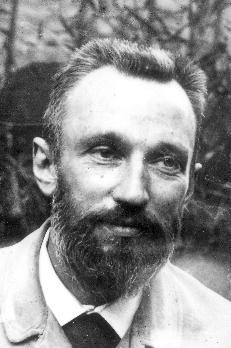Pierre Curie
Sorry. This page did not exist before I made it. If you go to "view history" there is only my username. You can even see where it says I created the page.
Pierre Curie by csyed3
Early Life
Pierre Curie was born on May 15, 1859 in Paris. His father, Eugène Curie, was a physician and began to teach Pierre Curie math and geometry from a very young age. He attended the Faculty of Sciences at the Sorbonne and earned his degree at the age of 18. Not having enough money to immediately proceed with his doctorate, he began work as a laboratory instructor. Shortly after, in 1880, Pierre Curie with the help of his older brother, Jacques Curie discovered that the compression of crystals causes an electric action potential. During his research he created an instrument he named the Curie Scale which could take very precise measurements needed for his work. The very next year the two brothers showed that the opposite was also true; placing crystals in an electric field would cause them to deform. This discovery is known as piezoelectric effects and it is used in crystal oscillators which are used in modern electronic circuits. While working in his lab he met Marie Curie, then Maria Skłodowska, and took her on as a lab student and into his research. Finally in 1895, he became Professor of Physics and got his Doctor of Science degree. This was the same year Maria agreed to marry him.
For more information on his wife, Marie Curie, please reference Marie Curie.
Scientific Contributions
Curie's Law
For his doctoral thesis, Pierre Curie studied various forms of magnetism including paramagnetism whereby an external magnetic field attracts objects, causing internal magnetic fields in the same direction. During his research he discovered that temperature had an effect on paramagnetism. He wrote a formula to predict this effect, known as Curie's Law. The formula is as follows.
Radioactivity
Wormholes (often referred to as the Einstein-Rosen Bridge) are hypothetical passages between far off points across the universe. Though the Theory of Relativity predicts the existence of wormholes, one has yet to be discovered. The wormhole concept of a shortcut across the universe has engaged prospects of teleportation, though there are a number of issue ranging from size to stability that prevent the survival of anything travelling through a wormhole.
Other
Fun Facts
Einstein was offered the position of President of Israel, but refused stating his lack of "natural aptitude and the experience to deal properly with people"
Einstein enjoyed sailing, playing violin, and smoking pipes.
"Albert Einstein is an anagram of 'Ten elite brains'"
Myths Debunked
Despite popular belief, Albert Einstein did not work on the Manhattan Project. The US Army refused to provide him the necessary security clearance, likely due to his liberal political ideology. Nevertheless, Einstein had written President Franklin D. Roosevelt a letter outlining the development of a fission uranium bomb, a decision he is said to have later regretted. Einstein's letter helped spur the development of nuclear weaponry.
The rumor that Einstein failed at mathematics in primary school is incorrect. By twelve, Einstein had already begun studying calculus and developing his own mathematical proofs!
See also
Further reading
l
External links
http://www.nobelprize.org/nobel_prizes/physics/laureates/1903/marie-curie-bio.html
http://www.biography.com/people/albert-einstein-9285408
http://www.pbs.org/wgbh/nova/physics/einstein-on-newton.html
References
gghhjkjkkgghgjkgfjjhjkhdhjahfjhasjkfhasjfhadsjkhjkahsgadsgjk
